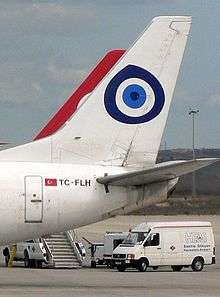Nazar (amulet)

A nazar (Turkish: nazar boncuğu, Old Turkic: gökçe munçuk, meaning "blue bead") is an eye-shaped amulet believed to protect against the evil eye. “Evil eye”, from boncuğu (derivative of boncuk, which means “bead” in Turkish) and nazar (from the Arabic نظر, “sight” or “seeing”).
In Persian folklore, it is called a cheshm nazar (چشم نظر) or nazar ghorboni (نظرقربونی).[1]
In Urdu, it is also called "nazar" (نظر).
Amulet
A typical nazar is made of handmade glass featuring concentric circles or teardrop shapes in dark blue, white, light blue and black, occasionally with a yellow/gold edge.[2]
As a legacy of the Turkish Ottoman Empire, it is a common sight in Turkey, Macedonia, Romania, Albania, Bosnia and Herzegovina, Bulgaria, Greece, Cyprus, Syria, Lebanon, Israel, Egypt, Armenia, Iran, Afghanistan, Pakistan, Iraq and Azerbaijan,[3] where the nazar is often hung in homes, offices, cars, children's clothing, or incorporated in jewellery and ornaments.[2] They are a popular choice of souvenir with tourists.
Salafist Muslim scholars, however, have rejected the use of such traditional amulets, including the evil-eye, stating that it is a form of Shirk - meaning associating with God.[4] The reason they forbid this is because one now believes protection is coming from the object rather than from God, or that it intercedes on behalf of an individual before God when it has no power to do such. The Standing Committee for Research and Fatwas of Saudi Arabia stated that these amulets are prohibited.[5] Similar was also mentioned by Wahhabi Shaykh Al-Albaanee.[6]
The evidence used for the prohibition is the narration in Musnad Ahmed from Muhammad which states: "Whoever hangs an amulet, then he has committed Shirk.[7]
Eye bead

The Turkish boncuk (sometimes called a göz boncuğu 'eye bead') is a glass bead characterized by a blue glass field with a blue or black dot superimposed on a white or yellow center. Historically old, the blue bead has gained importance as an item of popular culture in Modern Turkey. The bead probably originated in the Mediterranean and is associated with the development of glass making. Written documents and extant beads date as early as the 16th century BC. Glass beads were made and widely used throughout the ancient world: from Mesopotamia to Egypt, from Phoenicia to Persia, and throughout the Roman imperial period.
The eye bead is a kind of glass art based on nazar in Turkey. This art has changed very little for thousands of years. The 3,000-year-old antique Mediterranean glass art lives in these eye bead furnaces with its every detail.
The roots of the very few glass evil eye bead masters that still practice this tradition go back to the Arabian artisans who settled in Izmir and its towns during the decline of the Ottoman Empire by the end of the 19th century. The glass art that had lost its glamour in Anatolia, combined with the eye sign, was enlivened. The masters who practised their arts at Araphan and Kemeraltı districts of Izmir were exiled due to the disturbance of the smoke from their furnace and risk of fire in the neighbourhood.
Other uses and popular culture

The nazar image was used as a symbol on the tailfins of aeroplanes belonging to the private Turkish airline Fly Air.
It is used in the logo for CryEngine 3, a game engine designed by Crytek, a video game company founded by three Turkish brothers (Cevat, Avni and Faruk Yerli).
It was also used in the logo of the 2013 FIFA U-20 World Cup events.
The video game Terraria (2011) has an accessory item called "Nazar" which grants immunity to the "Cursed debuff".
Gallery
 Nazar-inspired sculpture in the Netherlands.
Nazar-inspired sculpture in the Netherlands. Nazar evil eye charms.
Nazar evil eye charms.- A Persian cheshm nazar.
- A Turkish nazar boncuğu.
 Nazar on a newborn baby's hospital room's door in Turkey.
Nazar on a newborn baby's hospital room's door in Turkey.
See also
References
| Wikimedia Commons has media related to Nazar boncuğu. |
- ↑ M.Moin: A Persian Dictionary, 3rd edition, p. 4752 (In Persian).
- 1 2 Lonely Planet Middle East.Lonely Planet; 6 edition, 2009, p. 559.
- ↑ Stoltz, Dustin (May 26th, 2012). "The Evil Eye and Mountain Karma in Azerbaijan". www.dustinstoltz.com. Check date values in:
|date=(help) - ↑ http://islamqa.info/en/10543
- ↑ Fataawaa Al-Lajnah Ad-Daa'mah, vol. 1, p.212
- ↑ Silsilat Al-Ahaadeeth As-Saheehah, vol. 1, p.890
- ↑ Musnad Al-Imaam Ahmed, Mu'assasat Ar-Risaalah print, vol. 28, p.637-638
Sources
- Ronald T. Marchese (2005). The Fabric of Life: Cultural Transformations in Turkish Society. pp. 103–107.